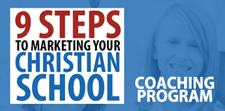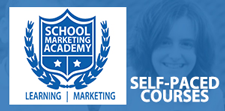
Your content can be created and curated. The latter is when you find links to other third-party sources that serve the needs of your audience (prospective families and/or current families, for example). The former is what you create yourself. Let’s examine the difference.
CURATION: for simplistic purposes, you follow some education expert on Twitter and you retweet her article. Later, on Pinterest, you click through a recipe only to find a link on the “Related Posts” to a great parenting resource that you post on Facebook for your parents’ attention. You did not write the content yourself, but you organized the content you found on external sites and shared it with your targeted audience. In the world of content marketing, that’s “curation”.
CREATION: this type of content exists on your campus, in the minds of your staff, in the experiences of your students and their parents and in the hallways of your buildings. When prospective families read a claim of “college preparatory” or “world changers” (both are fairly poor descriptive phrases unless backed up by proof), you must provide them with hard evidence to back of your claims. Sitting in the jury box, these potential parents are examining the evidence and the content you create helps build and back up your case.
So, whether you are curating or creating it, your content marketing must be targeted to your audience(s) – and most of the time should in one way or another, resonate with a felt need, problem, pain, frustration or fear they are experiencing. Your content calendar (download a CALENDAR and a GUIDE here to help you plan your year) must be robust, intentional and strategic.
Before outlining the 5 characteristics of compelling content, let’s review how content is shared (curated or created):
- Written (testimonials, articles, experts posts)
- Audio (podcasts, audio files)
- Visual (photos/graphics/videos)
So now you know that whether you are curating or creating content, your arsenal has been expanded beyond just “words on a page” and now includes other rich media. All three forms of content are valuable!
Finally, the 5 characteristics of great content:
- Content must tell stories – moving away from bullet points and billboards, we bring to life the experiences of families who have benefitted from their time at your school. Prospective families and students need personal stories with whom to connect. These stories remind them that they can fit in, they can relate and they will do well at your school. Remember: inspiration before information!
- Content must differentiate – in a cluttered and cloudy world, prospective families must be able to clearly distinguish you from your competition. The one-size-fits-all marketing messaging should more accurately be labeled, “one-size-hits-small”, a not-so-clever punch highlighting the reality that if our message is too broad, it reaches very few people (if any). Do not create a video testimonial that sounds like something your competition’s parents would say. Capture the unique angles of every family’s story and show how they differentiate your school.
- Content must educate – FAQ pages, webinars, free reports, survey data….these are examples of producing content that helps a prospective family cut through the clutter and make a clear decision. Even current families continually need education that will help them become further convinced of your value and also arm them with referral material to pass on to their friends at church, the soccer game or during a conversation at the coffee shop. I borrow from Jay Baer’s book, Youtility, in a post about providing HELPFUL content – read “You don’t attract families with promotional brochures“.
- Content that builds trust – prospective families may know who you are, know the competition and have you ranked in a private poll that is as dynamic as political races every 4 years. How do you stand out? One of the most powerful ways is to put forth “social proof” – the kind of content that displays to your jury of prospective families that not only are the marketing claims true, there are families willing to go on record to back you up! Grab as many reviews as you can possibly get in online forums (such as your Google listing, GreatSchools.org, PrivateSchoolReview.com and your school’s Facebook page “Reviews” tab). Start asking your best ambassador families to step up and record a video story or write their own testimonial and journey of coming to your school (be sure and have them include the barriers, obstacles and challenges). This content breaks down the wall of suspicion consumers who have been “marketed to” all their life. Whether it’s a hotel on the summer roadtrip, the latest tech gadget on Amazon, or their child’s education, what parent wouldn’t highly value the opinion of a family who has determined it valuable to enroll at your school.
- Content that enthuses – when polling my Twitter followers, Simon Hepburn (follow him @mktadvice4schls), suggested this idea: your content should “enthuse”. That’s so simple I almost overlooked it! Content, in written/audio/visual formats, should make parents and students take notice and compel them to inquire, apply and enroll! Be funny, be inspirational, be authentic and showcase your best!
Content is powerful when measured by characteristics that hold them to a higher standard than just the same ol’ stuff you see on every billboard, brochure and bullet point.
If you need help setting up your content strategy, we can help! We offer a free 30-minute phone consultation to show you how we integrate a targeted content marketing strategy inside your school’s customized marketing system.
-Randy
[Update]
** TWO ADDITIONAL IDEAS**
- Content that showcases – this is what I often call “scrapbook content”. These are things to promote that showcase various events, successes and daily snapshots of campus life of your school. These are the most compelling pieces of content, but it’s what I see the most. I would use this sparingly and created more targeted content that differentiates but I recognize there is a place for this type of content.
- Content that provides evidence – to be more specific than any of the 5 above, some content is created to back up claims that you make on your website, on your social platforms, or even things you say in person while giving a tour. Prospective families are looking for specific examples of how you are producing “world changers” or how you offer “superior academics”. Rarely make a claim without providing evidence to back it up! Read this article: “Show Me the Evidence”!







